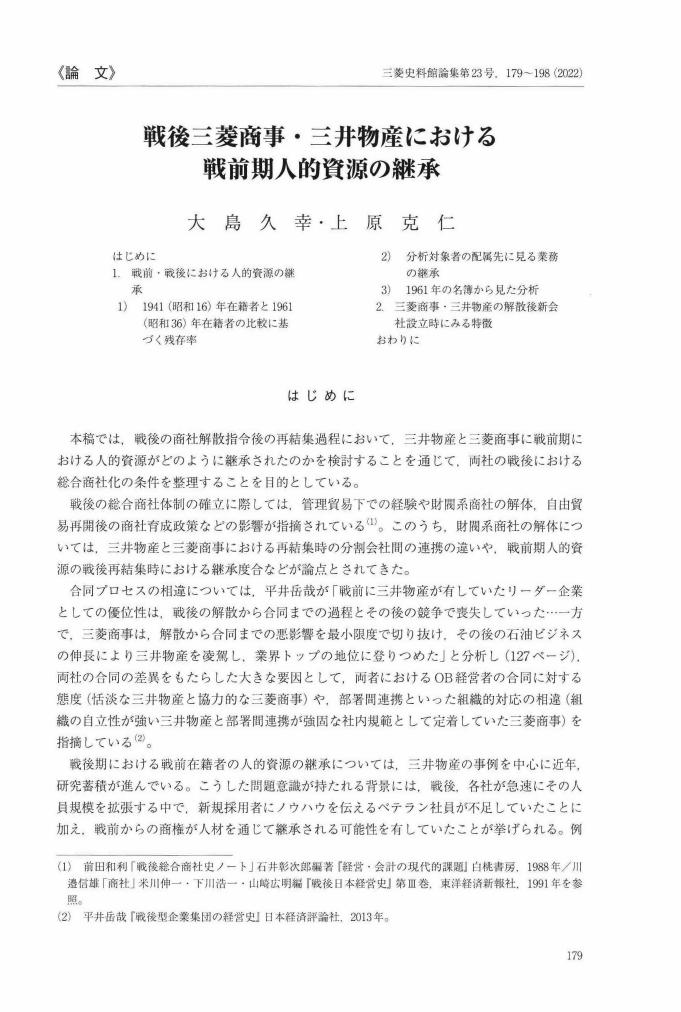6 0 0 0 OA 戦後三菱商事・三井物産における戦前期人的資源の継承
- 著者
- 大島 久幸 上原 克仁
- 出版者
- 公益財団法人 三菱経済研究所
- 雑誌
- 三菱史料館論集 (ISSN:13453076)
- 巻号頁・発行日
- vol.2022, no.23, pp.179-198, 2022-03-20 (Released:2023-07-27)
6 0 0 0 OA 三菱商事における学歴と昇進
- 著者
- 大島 久幸 中林 真幸
- 出版者
- 公益財団法人 三菱経済研究所
- 雑誌
- 三菱史料館論集 (ISSN:13453076)
- 巻号頁・発行日
- vol.2021, no.22, pp.1-18, 2021-03-20 (Released:2023-07-27)
3 0 0 0 OA 明治・大正期三菱合資会社営業部における海外店舗人材形成―三菱商事成立前史―
- 著者
- 大島 久幸 木山 実
- 出版者
- 公益財団法人 三菱経済研究所
- 雑誌
- 三菱史料館論集 (ISSN:13453076)
- 巻号頁・発行日
- vol.2023, no.24, pp.73-90, 2023-03-20 (Released:2023-08-01)
2 0 0 0 IR 戦間期における職員の評価と給与 : 食品製造企業N社を題材に
- 著者
- 永戸 哲也 大島 久幸 田口 和雄
- 出版者
- 高千穂大学高千穂学会
- 雑誌
- 高千穂論叢 (ISSN:03887340)
- 巻号頁・発行日
- vol.56, no.3, pp.1-19, 2021-11
2 0 0 0 三菱における航空機技術導入と三菱商事
- 著者
- 大島 久幸 Roy Alexandre
- 出版者
- 三菱経済研究所
- 雑誌
- 三菱史料館論集 = Mitsubishi Archives review (ISSN:13453076)
- 巻号頁・発行日
- no.21, pp.91-103, 2020
1 0 0 0 IR 戦前期商社業界における学閥形成
- 著者
- 木山 実 大島 久幸
- 出版者
- 慶應義塾福沢研究センター
- 雑誌
- 近代日本研究 (ISSN:09114181)
- 巻号頁・発行日
- no.37, pp.35-79, 2020
はじめに一 明治期から大正期にかけての学閥形成二 三井物産における慶應義塾卒業生おわりに特集 : 慶應義塾出身の経営者たち
- 著者
- 木山 実 大島 久幸
- 出版者
- 慶応義塾福沢研究センター
- 雑誌
- 近代日本研究 (ISSN:09114181)
- 巻号頁・発行日
- no.37, pp.35-79, 2020
1 0 0 0 三菱商事における学歴と昇進
- 著者
- 大島 久幸 中林 真幸
- 出版者
- 三菱経済研究所
- 雑誌
- 三菱史料館論集 = Mitsubishi Archives review (ISSN:13453076)
- 巻号頁・発行日
- no.22, pp.1-18, 2021
1 0 0 0 OA 両大戦間期における海運市場の変容と三井物産輸送業務
- 著者
- 大島 久幸
- 出版者
- Business History Society of Japan
- 雑誌
- 経営史学 (ISSN:03869113)
- 巻号頁・発行日
- vol.43, no.4, pp.4_3-4_27, 2009 (Released:2012-02-11)
The purpose of this paper is to analyze the relationship between changes in shipping markets and trading companies' shipping businesses from the first decade of the 1900s through the 1920s. In shipping markets during the period through the First World War, in which concentrated chartering markets such as the Baltic market played a very important role, Mitsui & Co. employed centralized management of branch offices, expanding its shipping sections, which constituted internal markets. However, as the role of liners grew with expansion of the scheduled shipping network beginning in the second half of the 1920s, the transportation functions of general trading companies began to operate in an autonomous and decentralized fashion at the branch offices that managed each scheduled service. At this time, large shippers such as Mitsui & Co. maintained their competitive strengths by concluding tariff contracts with under-the-table rebates. As a result of such changes in shipping functions, trading companies' domestic shipping sections were forced to choose whether to shift to common carriers or to contract in size through external sourcing of freight space. While under the leadership of its manager Kawamura the shipping division of Mitsui & Co. chose the former option, Mitsubishi Corp. chose the latter.
1 0 0 0 OA 戦時期におけるホワイトカラーの給与統制と賃金管理
- 著者
- 田口 和雄 大島 久幸
- 出版者
- 高千穂大学 高千穂学会
- 雑誌
- 高千穂論叢 = THE TAKACHIHO RONSO (ISSN:03887340)
- 巻号頁・発行日
- vol.54, no.2, pp.99-120, 2019-11-25

